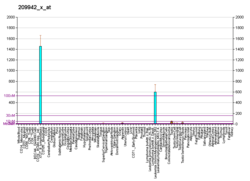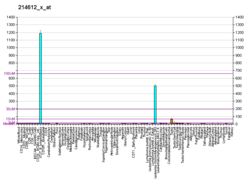MAGEA3
| MAGEA3 |
|---|
|
|
| Identifiers |
|---|
| Aliases | MAGEA3, CT1.3, HIP8, HYPD, MAGE3, MAGEA6, MAGE family member A3 |
|---|
| External IDs | HomoloGene: 55892 GeneCards: MAGEA3 |
|---|
| Gene location (Human) |
|---|
 | | Chr. | X chromosome (human)[1] |
|---|
| | Band | No data available | Start | 152,698,752 bp[1] |
|---|
| End | 152,702,347 bp[1] |
|---|
|
|
|
| Orthologs |
|---|
| Species | Human | Mouse |
|---|
| Entrez | | |
|---|
| Ensembl | | |
|---|
| UniProt | | |
|---|
| RefSeq (mRNA) | | |
|---|
| RefSeq (protein) | | |
|---|
| Location (UCSC) | Chr X: 152.7 – 152.7 Mb | n/a |
|---|
| PubMed search | [2] | n/a |
|---|
| Wikidata |
|
Melanoma-associated antigen 3 (MAGE-A3) is a protein that in humans is encoded by the MAGEA3 gene.[3][4][5]
Genetics
This gene is a member of the melanoma-associated antigen gene family. The members of this family encode proteins with 50 to 80% sequence identity to each other. The promoters and first exons of the MAGEA genes show considerable variability, suggesting that the existence of this gene family enables the same function to be expressed under different transcriptional controls. The MAGEA genes are clustered at chromosomal location Xq28. They have been implicated in some hereditary disorders, such as dyskeratosis congenita.[5]
Function and Clinical relevance
The normal function of MAGE-A3 in healthy cells is unknown.[6] The presence of the antigen on tumor cells has been associated with worse prognosis. In one study, high levels of MAGE-A3 in lung adenocarcinoma were associated with shorter survival.[7]
MAGE-A3 is a tumor-specific protein, and has been identified on many tumors including melanoma, non-small cell lung cancer, hematologic malignancies, among others.[8] Currently, GlaxoSmithKline is developing a cancer vaccine targeting MAGE-A3. The vaccine is a fusion protein of MAGE-A3 and Haemophilus influenzae protein D, combined with a proprietary immunoadjuvant.[9]
References
- 1 2 3 GRCh38: Ensembl release 89: ENSG00000221867 - Ensembl, May 2017
- ↑ "Human PubMed Reference:".
- ↑ van der Bruggen P, Traversari C, Chomez P, Lurquin C, De Plaen E, Van den Eynde B, Knuth A, Boon T (Jan 1992). "A gene encoding an antigen recognized by cytolytic T lymphocytes on a human melanoma". Science. 254 (5038): 1643–7. PMID 1840703. doi:10.1126/science.1840703.
- ↑ Rogner UC, Wilke K, Steck E, Korn B, Poustka A (Mar 1996). "The melanoma antigen gene (MAGE) family is clustered in the chromosomal band Xq28". Genomics. 29 (3): 725–31. PMID 8575766. doi:10.1006/geno.1995.9945.
- 1 2 "Entrez Gene: MAGEA3 melanoma antigen family A, 3".
- ↑ Decoster L, Wauters I, Vansteenkiste JF (Dec 2011). "Vaccination therapy for non-small-cell lung cancer: review of agents in phase III development.". Annals of Oncology. 23: 1387–1393. PMID 22156658. doi:10.1093/annonc/mdr564.
- ↑ Ali O. Gure; Ramon Chua; Barbara Williamson; Mithat Gonen; Cathy A. Ferrera; Sacha Gnjatic; Gerd Ritter; Andrew J.G. Simpson; Yao-T. Chen; Lloyd J. Old; Nasser K. Altorki (Nov 2005). "Cancer-Testis Genes Are Coordinately Expressed and Are Markers of Poor Outcome in Non–Small Cell Lung Cancer". Clinical Cancer Research. 11 (22): 8055–8062. PMID 16299236. doi:10.1158/1078-0432.CCR-05-1203.
- ↑ Corporate Comms. "New data on MAGE-A3 cancer immunotherapy support potential novel options of treating non-small cell lung cancer and melanoma". Us.gsk.com. Retrieved 2012-10-16.
- ↑ "Patent US20100008980 - Use of MAGE A3-Protein D Fusion Antigen in Immunotherapy Combined with ... - Google Patents". Google.com. 2008-01-08. Retrieved 2012-10-16.
Further reading
- Brasseur F, Rimoldi D, Liénard D, et al. (1995). "Expression of MAGE genes in primary and metastatic cutaneous melanoma.". Int. J. Cancer. 63 (3): 375–80. PMID 7591235. doi:10.1002/ijc.2910630313.
- Kocher T, Schultz-Thater E, Gudat F, et al. (1995). "Identification and intracellular location of MAGE-3 gene product.". Cancer Res. 55 (11): 2236–9. PMID 7757970.
- De Plaen E, Arden K, Traversari C, et al. (1994). "Structure, chromosomal localization, and expression of 12 genes of the MAGE family.". Immunogenetics. 40 (5): 360–9. PMID 7927540. doi:10.1007/BF01246677.
- Ding M, Beck RJ, Keller CJ, Fenton RG (1994). "Cloning and analysis of MAGE-1-related genes.". Biochem. Biophys. Res. Commun. 202 (1): 549–55. PMID 8037761. doi:10.1006/bbrc.1994.1963.
- Gaugler B, Van den Eynde B, van der Bruggen P, et al. (1994). "Human gene MAGE-3 codes for an antigen recognized on a melanoma by autologous cytolytic T lymphocytes". J. Exp. Med. 179 (3): 921–30. PMC 2191409
 . PMID 8113684. doi:10.1084/jem.179.3.921.
. PMID 8113684. doi:10.1084/jem.179.3.921.
- Maruyama K, Sugano S (1994). "Oligo-capping: a simple method to replace the cap structure of eukaryotic mRNAs with oligoribonucleotides". Gene. 138 (1–2): 171–4. PMID 8125298. doi:10.1016/0378-1119(94)90802-8.
- Valmori D, Liénard D, Waanders G, et al. (1997). "Analysis of MAGE-3-specific cytolytic T lymphocytes in human leukocyte antigen-A2 melanoma patients". Cancer Res. 57 (4): 735–41. PMID 9044853.
- Suzuki Y, Yoshitomo-Nakagawa K, Maruyama K, et al. (1997). "Construction and characterization of a full length-enriched and a 5'-end-enriched cDNA library". Gene. 200 (1–2): 149–56. PMID 9373149. doi:10.1016/S0378-1119(97)00411-3.
- Mallon AM, Platzer M, Bate R, et al. (2000). "Comparative Genome Sequence Analysis of the Bpa/Str Region in Mouse and Man". Genome Res. 10 (6): 758–75. PMC 310879
 . PMID 10854409. doi:10.1101/gr.10.6.758.
. PMID 10854409. doi:10.1101/gr.10.6.758.
- Jang SJ, Soria JC, Wang L, et al. (2001). "Activation of melanoma antigen tumor antigens occurs early in lung carcinogenesis". Cancer Res. 61 (21): 7959–63. PMID 11691819.
- Consogno G, Manici S, Facchinetti V, et al. (2003). "Identification of immunodominant regions among promiscuous HLA-DR-restricted CD4+ T-cell epitopes on the tumor antigen MAGE-3". Blood. 101 (3): 1038–44. PMID 12393675. doi:10.1182/blood-2002-03-0933.
- Strausberg RL, Feingold EA, Grouse LH, et al. (2003). "Generation and initial analysis of more than 15,000 full-length human and mouse cDNA sequences". Proc. Natl. Acad. Sci. U.S.A. 99 (26): 16899–903. PMC 139241
 . PMID 12477932. doi:10.1073/pnas.242603899.
. PMID 12477932. doi:10.1073/pnas.242603899.
- Guo J, Wen DR, Huang RR, et al. (2003). "Detection of multiple melanoma-associated markers in melanoma cell lines by RT in situ PCR". Exp. Mol. Pathol. 74 (2): 140–7. PMID 12710945. doi:10.1016/S0014-4800(03)00012-1.
- Zerbini A, Pilli M, Soliani P, et al. (2004). "Ex vivo characterization of tumor-derived melanoma antigen encoding gene-specific CD8+cells in patients with hepatocellular carcinoma". J. Hepatol. 40 (1): 102–9. PMID 14672620. doi:10.1016/S0168-8278(03)00484-7.
- Gerhard DS, Wagner L, Feingold EA, et al. (2004). "The Status, Quality, and Expansion of the NIH Full-Length cDNA Project: The Mammalian Gene Collection (MGC)". Genome Res. 14 (10B): 2121–7. PMC 528928
 . PMID 15489334. doi:10.1101/gr.2596504.
. PMID 15489334. doi:10.1101/gr.2596504.
- Zhou M, Peng JR, Zhang HG, et al. (2005). "Identification of two naturally presented MAGE antigenic peptides from a patient with hepatocellular carcinoma by mass spectrometry". Immunol. Lett. 99 (1): 113–21. PMID 15885805. doi:10.1016/j.imlet.2005.02.007.
- Hudolin T, Juretic A, Spagnoli GC, et al. (2006). "Immunohistochemical expression of tumor antigens MAGE-A1, MAGE-A3/4, and NY-ESO-1 in cancerous and benign prostatic tissue". Prostate. 66 (1): 13–8. PMID 16114059. doi:10.1002/pros.20312.
- Miyagawa N, Kono K, Mimura K, et al. (2006). "A newly identified MAGE-3-derived, HLA-A24-restricted peptide is naturally processed and presented as a CTL epitope on MAGE-3-expressing gastrointestinal cancer cells". Oncology. 70 (1): 54–62. PMID 16446550. doi:10.1159/000091185.
 . PMID 8113684. doi:10.1084/jem.179.3.921.
. PMID 8113684. doi:10.1084/jem.179.3.921. . PMID 10854409. doi:10.1101/gr.10.6.758.
. PMID 10854409. doi:10.1101/gr.10.6.758. . PMID 12477932. doi:10.1073/pnas.242603899.
. PMID 12477932. doi:10.1073/pnas.242603899. . PMID 15489334. doi:10.1101/gr.2596504.
. PMID 15489334. doi:10.1101/gr.2596504.


